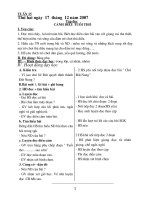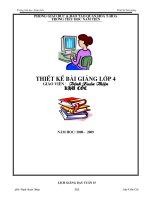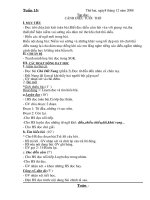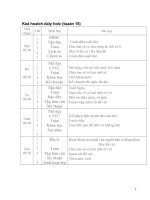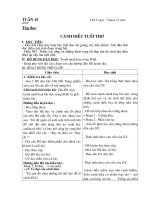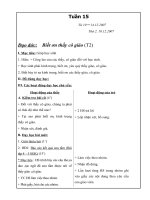tieng anh Tu lop 4 tuan 15
Bạn đang xem bản rút gọn của tài liệu. Xem và tải ngay bản đầy đủ của tài liệu tại đây (104.29 KB, 14 trang )
<span class='text_page_counter'>(1)</span>Tuesday, August 29th, 2017. Week 1. Starter: Welcome back! Lesson 1: Period 1+2 I.. Aim: By the end of the lesson, students will be able to identify different places in a house. II.. Language contents: Vocabulary: Welcome back, kitchen, bedroom, coat, shoes, grandma. III.. Teaching aids: class book, CD tracks. IV.. Steps of teaching 1. Warm up: Come into class, smile and say “Hello” and encourage students to say “Hello” back to you. 2. Presentation: Listen and sing -. Ask students to open class book at page 4. -. Have students look at three children at the top of the page. -. Point to each one and ask students to tell their names. -. Tell students they are going to begin the lesson with a song “ Welcome back”. -. Play the CD for students to listen and follow the song. -. Read each line for students to repeat after you. -. Play the song again for students to sing along. Sing and do -. Ask students to think of some actions for the song. -. Call some groups of four to sing and do the actions. Listen and read -. Have students look at the story in their books and ask them: How many people are there? And Who are they? Which rooms can you see? What is Rosy doing? Where’s Grandma?. -. Play the CD and ask students to follow the words in the story.
<span class='text_page_counter'>(2)</span> -. Play the CD again and pause in each line for students to repeat. -. Have students work in group to answer some questions Is grandma in the kitchen? Is Billy in his bedroom? Is he behind the door? Is he under the table?. 3. Practice: Describe the character from the story for students to guess who he/she is, ex: she’s in the kitchen. Call another student to describe the character for other students to guess.. Thursday, August 31st , 2017. Week 1. Starter: Welcome back! Lesson 2: Period 3+4 I.. Aim: By the end of the lesson, students will be able to introduce friends. II.. Language contents: Structure: This is my……His name’s…./ Her name’s…..He’s…./ She’s…. III.. Teaching aids: class book, CD tracks. IV.. Steps of teaching 1. Warm up: have students sing the song Welcome back! to warm up the class 2. Presentation: Listen to the story again and repeat. Act -. Play the CD again and have students repeat each line. -. Have students work in groups and act out the story. -. Call some groups to act out in front of the class. Read again and circle True (T) or False (F) -. Call a student to read the exercise in the book. -. Divide the board into two and write the exercise on both sides.
<span class='text_page_counter'>(3)</span> -. There will be two groups of six doing this exercise. -. The winner is the fastest and rightest team. -. Have students do the exercise in their books. Ask and answer -. Ask a student to read the dialogue. -. Ask students to practice the dialogue in pairs. -. Call some pairs to say aloud for the class. Look and say. Introduce a friend -. Explain that students in the picture are introducing a friend to someone else. -. Ask a student to read the first speech aloud. -. Divide the class into groups of three. -. Students introduce their friends to each other. 3. Practice: Ask students to stand in a circle. Ask the first student to introduce the person on his left to the person on his right. The person on the right then introduces the one on his left. Continue in this way around the class to introduce the friend.. Tuesday, September 5th , 2017. Week 2. Starter: Welcome back! Lesson 3: Period 5 + 6 I.. Aim: By the end of the lesson, students will be able to identify toys and possession. II.. Language contents: Vocabulary: car, teddy, kite, doll, ball, puzzle. III.. Teaching aids: class book, CD tracks. IV.. Steps of teaching.
<span class='text_page_counter'>(4)</span> 1. Warm up: give each group a paper with the letters. Ask them to find the words: doll, ball, puzzle, car, kite, teddy 2. Presentation: Look at the picture. Then write -. Have students look at the picture in their books and ask them Who are in the picture? What are they doing? Name all the toys in the picture. -. Read the words in the box, pointing out possessive ’s in both cases. -. Ask a student to read the example sentence. -. Students complete the sentences with the correct name for each toy. -. Call five students to read the completed sentences to check. Point, ask and answer -. Ask a student to read the example dialogue. -. Ask students to practice in pairs. -. Encourage them to point different items in the picture. -. Call some pairs to say aloud for the class. Listen and sing -. Tell that they are going to listen to the song. -. Have students look at their books and ask them to guess the content of the song. -. Play the song for them to follow the words. -. Play again and ask them to sing along. Sing and do -. Play the song again. -. Ask students to name the actions for the song. -. Call some groups of two to sing the song and do the actions. 3. Practice: have students play Guessing game..
<span class='text_page_counter'>(5)</span> Thursday, September 7th , 2017. Week 2. Starter: Welcome back! Lesson 4: Period 7+8 I.. Aim: By the end of the lesson, students will be able to identify school things and colours. II.. Language contents: Vocabulary: book, pencil, pen, rubber, ruler, bag, red, blue, black, green, pink Structure: I’ve got….I haven’t got….. III.. Teaching aids: class book, CD tracks. IV.. Steps of teaching 1. Warm up: have students sing the song Monday, Tuesday, Wednesday, Jump! 2. Presentation: Listen and tick -. Have students look at the picture in their books and ask them Where are Sarah and Luke? What can you see at the park? What colour are Sarah’s shoes? What colour are Luke’s shoes? What colour is Sarah’s bag? What colour is Luke’s bag?. -. Have students listen and tick the correct pictures. -. First, play the CD for students to listen the whole text. -. Second, play the CD again but pause in each line for them to tick. -. Finally, play the CD once more time for them to check their answers. Look at the table again. Ask and answer -. Have students look at the table they have done again. -. Call a student to read the sentence in the book. -. Have students read the sentence aloud. -. Have students work in pairs to practise. -. Call some strong pairs to say aloud for the class.
<span class='text_page_counter'>(6)</span> Now talk about your school bag -. Tell students they are going to talk about their school bags. -. Teacher models first. -. Call some students to talk about their school bags in front of the class. 3. Practice: have students slap the board of spoken words: book, swing, blue, pencil, school bag, rubber, black, green. Tuesday, September 12th , 2017. Week 3. Unit 1: A new friend Lesson 1: Period 9+10 I.. Aim: By the end of the lesson, students will be able to describe someone’s appearance. II.. Language contents: Vocabulary: long, short, blond, brown, curly, straight. III.. Teaching aids: class book, CD tracks, flashcards. IV.. Steps of teaching 1. Warm up: remind students of the last story. Tell students that the story is about friends. Ask some students to tell you the name of one of their friends. 2. Presentation: Listen, point and repeat -. Put your hands on your own hair. Say the word hair and write it up on the board. -. Use flashcards 1-6 to elicit the vocabulary for this lesson. -. Hold them up one at a time and ask Long or short hair? Blond or brown hair? Curly or straight hair?. -. Hold the flashcards up in a different order and repeat..
<span class='text_page_counter'>(7)</span> -. Have students look at their books. -. Play the CD for students to listen and point to the correct pictures. -. Play again for them to listen and repeat. - Call some students to repeat the words Listen and chant -. Play the CD for students to listen the chant. -. Play again for them to listen and say the words. Listen and read -. Have students look at the story at page 8 and ask them What’s happening in the story? How many people are there? Where are they?. -. Play the CD and ask students to point to each speech. -. Play again but pause in each line for them to repeat. -. Check their comprehension by asking some questions Who’s Rosy’s new friend? What’s Alice got? Who’s Tim’s new friend? Are the new friends cousins?. 3. Practice: Ask six students to come to the front of the class. Give each student one of the flashcards (1-6). Play the CD again. The students at the front stamp their feet when their hair type is mentioned.
<span class='text_page_counter'>(8)</span> Thursday, September 14th , 2017. Week 3. Unit 1: A new friend Lesson 2: Period 11+12 I.. Aim: By the end of the lesson, students will be able to describe someone’s appearance. II.. Language contents: Vocabulary: long, short, blond, brown, curly, straight Structure: He’s got….He hasn’t got…. She’s got……She hasn’t got…... III.. Teaching aids: class book, CD tracks, flashcards. IV.. Steps of teaching 1. Warm up: Play Board slap with the students. Put the appearance flashcards on the whiteboard and bring up two teams of 3 students to the front. Two students from each team compete against each other to slap the correct flashcard as the teacher spells the word. The first student to touch for their team wins a point. 2. Presentation: Listen to the story again and repeat. Act -. Ask students to remind the content of the story. -. Play the CD for them repeat. -. Have students work in groups to act out the story. -. Call some groups to act in front of the class. Look and say -. Have students look at part 2 and call one by one student to read aloud the sentences in the book. -. Hold up different flashcards asking students to describe the person in each flashcard. -. Note that He’s got = He has got, he hasn’t got = he has not got. Write.
<span class='text_page_counter'>(9)</span> -. Put flashcards on the board again and write a gapped sentence like the ones in the Class Book eg: He…………..straight hair. She……….curly hair. -. Elicit the target structure and get two children to come to the front to write the missing words. -. Then students do in their books. -. Go around and check their answers. Look at the pictures again. Say and answer -. Have students look at the pictures at ex 3 again. -. Call a student to read aloud the dialogue. -. Ask one student to say what each person has got/ hasn’t got, the other guesses the number. 3. Practice: ask students to choose a friend in the class and describe her/ his appearance.. Tuesday, September 19th , 2017. Week 4. Unit 1: A new friend Lesson 3: Period 13+14 I.. Aim: By the end of the lesson, students will be able to identify and describe shapes. II.. Language contents: Vocabulary: square, circle, triangle, rectangle. III.. Teaching aids: class book, CD tracks, flashcards. IV.. Steps of teaching 1. Warm up: play a game Whispers to warm up the class 2. Presentation: Listen, point and repeat -. Use flashcards 7-10 to introduce the new words.
<span class='text_page_counter'>(10)</span> -. Hold up each one and say the words for students to repeat.. -. Draw one of the shapes on the board, with one side missing. Ask a student to come to the front and draw the missing side. -. The class calls out the name of the shape. Repeat with the rest of the shapes.. -. Ask students to look at their books and play the CD for them to point to the correct pictures. -. Play again for students to listen and repeat. -. Call some students to say the words aloud. Listen and sing -. Tell students they are going to listen to the song It’s a square. -. First, play the CD for students to listen the whole song. -. Second, play again but pause in each line for them to repeat. -. Pay attention to difficult words. -. Finally, play once more time for them to sing along with the CD. Sing and do -. Tell children they are going to sing the song again, but this time they are going to do the actions. -. Call some groups of four to sing and do the actions e.g: It's got three/ four sides - hold up right number of fingers. It hasn't got sides - shake heads. It's a square /circle /rectangle /triangle! - draw shapes in the air.. 3. Practice: Tell students that they are going to make pictures out of the shapes in this lesson. Divide the class into groups of four to six. Give each student a piece of plain paper and each group a selection of coloured shapes and a glue stick. Students make pictures by sticking the shapes onto their piece of paper..
<span class='text_page_counter'>(11)</span> Thursday, September 21st , 2017. Week 4. Unit 1: A new friend Lesson 4: Period 15+16 I.. Aim: By the end of the lesson, students will be able to say, recognize and write letter th. II.. Language contents: Vocabulary: three, bath, teeth. III.. Teaching aids: class book, CD tracks, flashcards. IV.. Steps of teaching 1. Warm up: play the song It’s a square to warm up 2. Presentation: Listen, point and repeat -. Tell students that today they will be looking at the letters th that represent the sound /θ/. -. Write th on the board in large letters. -. Model the sound for students to repeat. -. Hold up phonics cards 33-35 one at a time, saying the words for the class to repeat.. -. Hold them up in a different order and repeat... -. Ask students to look at their books and play the CD for them to point to the correct pictures. -. Play again for students to listen and repeat. -. Call some students to say the words aloud. Listen and chant -. Students join in with the chant. -. Play the chant for students to listen. -. Put the three cards around the room and students point as they say the chant. Read the chant again. Circle the th sound.
<span class='text_page_counter'>(12)</span> -. Read the text for students to follow and model the activity first on the board. -. Then students read and circle the sounds at the start of the words. Look at the picture and circle the correct sound -. Ask students to look at the picture and circle the correct sound. -. Model the first picture. -. Students do in their books. -. Go around and check their answers. 3. Practice: Write the words from Exercise 4 on the board. Theo, ten, three, slide. Ask students to work in groups in 3 minutes. Ask each group to find more words which have the same sounds as the words listed. The group who can find more words win the game.. Tuesday, September 26th , 2017. Week 5. Unit 1: A new friend Lesson 5: Period 17+18 I.. Aim: By the end of the lesson, students will be able to read and understand the text. II.. Language contents: Vocabulary: long, blond, short, curly, brown, straight. III.. Teaching aids: class book, CD tracks, flashcards. IV.. Steps of teaching 1. Warm up: play Slow reveal 2. Presentation: How many friends can you see? -. Ask students to look at p 12 and tell you what they can see. -. Ask them to look at the bottom of the letter to see who wrote it. -. Encourage them to name the park things in the background and predict what the letter is about.
<span class='text_page_counter'>(13)</span> Listen and read -. Explain that students are going to listen to Sally reading her letter. -. Play the CD for them to listen and follow the words in their books.. -. Play again and pause in each line for them to repeat. -. Call some students to read the letter. -. Check comprehension by asking Who is the letter to/ from? Who is Sally's best friend? Is Toby short? Where is Sally in the picture?. Read again. Write the names -. Ask students to look at the picture in Exercise 2 again.. -. They read the letter again and write down the names of the other children.. -. Go through the answers with the class. 3. Practice: Give out blank pieces of paper to each student. Read a description of a boy slowly, e.g. He's small. He's got blue eyes. He's got short, curly hair. It's brown. Students listen to the description and draw and colour what they hear. Repeat with a description of a girl. At the end, students compare their pictures.. Thursday, September 28th , 2017. Week 5. Unit 1: A new friend Lesson 6: Period 19+20 I.. Aim: By the end of the lesson, students will be able to ask and answer about appearance. II.. Language contents: Vocabulary: long, blond, short, curly, brown, straight. III.. Teaching aids: class book, CD tracks, flashcards. IV.. Steps of teaching.
<span class='text_page_counter'>(14)</span> 1. Warm up: Ask a student to come before the class. Ask the class to describe him / her, e.g. She's got blond hair. She's got blue eyes. She's tall. Repeat with other students 2. Presentation: Listen and number -. Ask students to look at the picture on page 13.. -. Point to the different students for the class to describe them.. -. Explain that they are the same students from the previous lesson. Ask what their names are.. -. Tell students that they are going to hear a recording of people describing the students in the picture. -. Ask students to listen and number. Look at the picture again. Ask and answer -. Call a student to read the speech in the book. -. Have students work in pairs to practise. -. One student says what he/ she has got and another one answers what number. -. Call some pairs to say in front of the class. Circle ’s and ’ve and match -. Write I've got blue eyes and She's got black hair onto the board. -. Circle I've and She's and ask students what the long forms are. -. Write the long forms next to each sentence. -. Have students circle and match in their books. -. Go and check their answers. -. Ask students what words 's and ‘ve are short for and they fill in the answers in their books. 3. Practice: ask students to write the short form of five sentences in the letter at page 12.
<span class='text_page_counter'>(15)</span>

